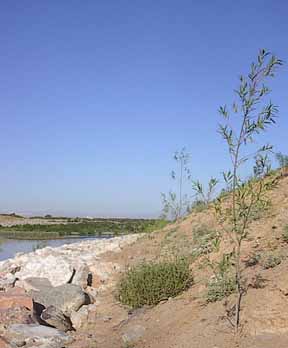
What is being done < previous | 1 | 2 | 3 | 4 | next >
Erosion is being addressed through engineering. Currently, portions of the Wash where the banks are defined by vertical bluff like faces are subject to major erosion as large chunks of soil slough off during floods. To combat this, heavy machinery is being brought in and the slopes are being cut back and recontoured to increase stability. The base of these slopes is then armoured with rock riprap to prevent them from being undercut by flood waters.

While less extreme than converting the Wash into a cement lined conduit, such earthmoving is none-the-less a major intervention. Saltcedar is removed in the process, though root fragments and seeds remain as propagules. It is hoped that subsequent establishment of native riparian species (photo at right) will limit the regeneration of Saltcedar, as well as softening the impact.
The result is a highly engineered waterway. In addition to the recontoured slopes and riprap lined channel, there are a series of impoundments to slow flow, and rapids to regulate the rate of drop (see photo above).
Despite the fact that the vegetation being planted is native to the area, it is not what was on the site previously. It is probably more accurate to describe such work as afforestation (establishment of a forest where one did not exist before) than restoration. Given the loss of the Colorado under Lake Mead however, it does provide an opportunity replace habitat that has been lost in the area, even if not on the site.
Continued: Replanting the Wash
< previous | 1 | 2 | 3 | 4 | next >


